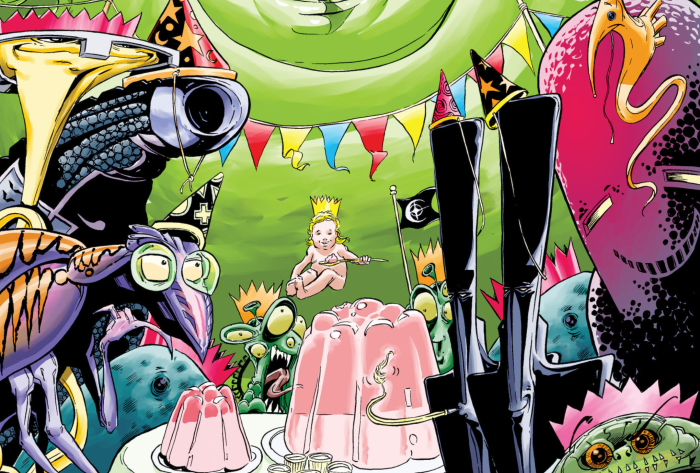With regards to form, very little separate the comic book or the graphic novel from its close cousin, the children’s book. The former is told entirely through pictures, with writing superimposed over the illustrations themselves, whether in the form of dialogue balloons, thought bubbles, or narration boxes. The later alternates between writing and illustrations, with the written sections obeying all the rules regularly applied to prose. Far more than form, the real difference which separates these two media is content.
Comics, despite having begun as pulp fiction aimed at prepubescents and adolescents, have come of age over the last seventy-five years; they are free to convey the rich spectrum of adult experiences: angst, cynicism, ennui, excitement, horror, inspiration, melancholy, resolve, titillation… nothing is beyond their purview. Children’s literate is usually more narrow in its emotional range, but there are at least a few feelings, such as enchantment and whimsy, that it typically excels at better than most adult literature.
In Miracleman #4, Gaiman succeeds in marrying the comic book and the children’s book together, not just in its form by having the panel layout of certain pages take on the trapping of a children’s book, but by capturing within those pages a sense of wonderment and whimsy… along with cynicism, disillusionment, ennui, and more.
The pattern for this issue is the same as it’s been for all of Gaiman’s run: the point of view is that of an everyday denizen old enough to have experienced and remember the ignosticism of an age before gods walked the earth with man. In their contemplation on a particular member of the new pantheon Gaiman does the work of world-building and character exploration all at once. The focus this issue is on Winter, the infant goddess of childhood and youth. Given the subject matter, the form of a children’s book natural followed.
The particular children reading this, an adoptive brother and sister, could not be more different, their racial distinctions being the least of their divide. The elder boy is altogether human, with all the feebleness and flaws and foibles that implies. The younger girl numbers among Miracleman’s basters, taking more after their father’s divinity than their mothers humanity. Each brings a unique perspective to their reading of Winter’s Tale, but more importantly their familial drama, which also includes the boy’s widower father and the girl’s decisively non-Madonna mother, ground the enchantment of their bedtime story in the disenchantment of Gaiman’s overarching story. As the girl Mist herself notes:
“Metafictions have an intrinsic distancing effect I think you’re foolish to ignore. The ideas are strong, but if you can’t care about the people, then what does it matter?”
Buckingham draws Mist in this panel looking directly forward. The intended effect is clear: she is staring through the fourth wall, her eyes directly meeting the reader’s, her word’s and message Gaiman’s own. He’s been telling a story of strong ideas and grandiose concepts, but always from the perspective of mortal men to whom the reader can relate. Because the reader not only cannot truly care about the gods, he cannot even full know the gods that Moore and Gaiman have created, except so far as he can anthropomorphize them in his mind; and “if you can’t care about the people, then why does it matter.”
Gaiman makes you care in this issue. Gaiman makes it matter.
9.25/10




Pingback: The Ultimates #3 | The Hub City Review
Pingback: We’re Living in the Postmodern Age of Comics | The Hub City Review
Pingback: Ninjak #18 | The Hub City Review
Pingback: Superman #18 | The Hub City Review